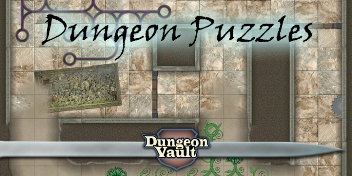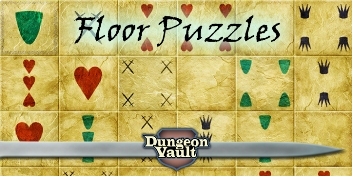Mazes and Labyrinths speak to the imagination. Caught in a maze, you never know what’s around the corner or if you are even getting closer to the exit. Of course, a minotaur might know but we’re afraid to ask. While mazes are amazing, pun intended, they don’t always translate well into the format of Dungeons & Dragons. Having your character aimlessly wander around for hours might sound like fun, but in terms of gameplay, it’s tiresome.
So what do you do to spice things up? You turn your D&D labyrinth into a puzzle! In this article, we’ll look at three ways for turning a dreary maze into a challenging puzzle.
1. Runestone Maze Puzzles for Dungeons & Dragons
The first type of puzzles we like to use are Runestone Puzzles. This illustrated puzzle pack allows you to create an infinite amount of puzzle designs. For our maze set up, we like to lay out pathways made completely out of black and white runestones. But the paths are not all connected.
To create connections, players will have to collect green runestones. These green runestones might of course be traded by the creatures who live in the maze. Or players can fight monsters to collect stones. The DM controls what adventures PCs need to undertake and how many stones they are able to collect.
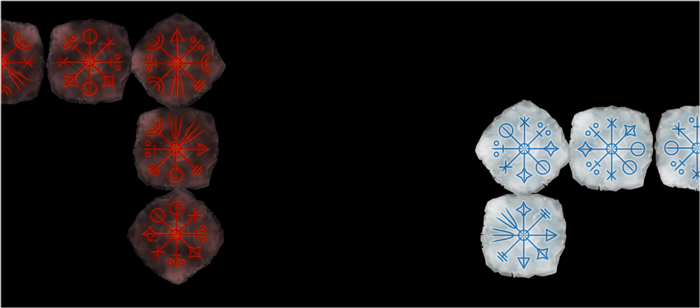
With the green Runestones, PCs can create a bridge between paths. These stones are pocket-sized up until the moment they are placed to form a pathway. Then they become stepping stones.
Of course, PCs can’t just connect any stones. This is where the puzzle aspect comes in. The symbols on the stones need to match up (like domino’s). Once, all players have crossed to the next path the green stones disappear. But exploring the next area of the labyrinth is sure to unearth even more runestones.

The great thing about this puzzle is that the DM controls where PCs can go and how long they need to stay in an area to find enough runestones. And participating in adventures as a means of finding stones becomes an easy motivation. The treasure is also more meaningful. Often when we just hand out treasure PCs are happy to have gained more gold pieces but have no idea how to spend them. With runestones, treasure IS the means of moving forward.
YOU MAY ALSO LIKE:
2. Dungeon Maze Puzzles for Dungeons & Dragons
Our second puzzle pack is Dungeon Puzzles, available in our webshop. This one is a very different take on maze puzzles. With dungeon puzzles, the entire dungeon IS the puzzle. Here’s how it works:
PCs are given a fragmented map of a building (or piece of the labyrinth). The pieces have become scrambled through magic or mechanical means, your choice. They can rotate the pieces of the dungeon on the map in their place so all hallways match up. This is the puzzle part. If they are successful the actual dungeon pieces also start to rotate to match up. If PCs solve the puzzle successfully they can enter the maze.
There are 30 premade puzzles in this pack that can all be linked together. If players solve the first maze puzzle and enter the labyrinth you can hide the next doorway and map somewhere in the maze.
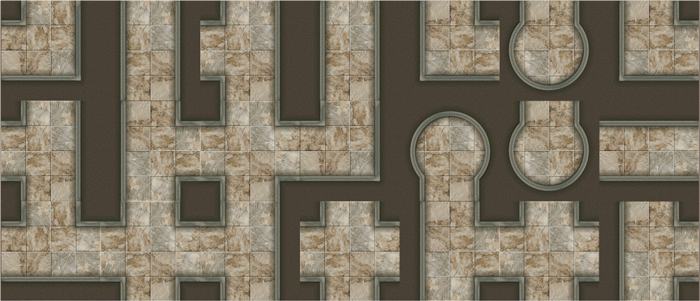
The genius thing about this puzzle is that, when solving the puzzle, the players are given 4 by 4-inch dungeon tiles that come with the puzzle pack. They can lay out the dungeon and, following the rules, solve the puzzle. When they do you immediately have a map to play on.
So in solving the maze puzzle players have laid out the map for the next area of your labyrinth. All you need to do is add doors, monsters, and the occasional cave-in.
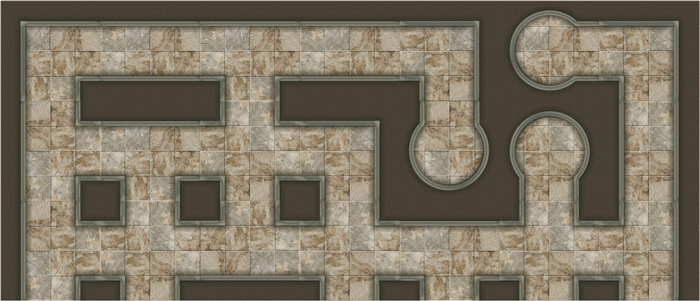
This pack also comes with cave tiles if you wish to change it up. And all puzzle packs mentioned in this article have pieces for both physical tabletop play and virtual tabletops. If you’re doing more of an Underdark type of maze these puzzles are ideal.
YOU MAY ALSO LIKE:
3. Floor Maze Puzzles for Dungeons & Dragons
Our third pick is Floor Puzzles. It is a bit of an unusual choice because with this maze puzzle PCs need to find and walk the correct path over a field of floor tiles. There are a lot of dead ends, just like in a maze, and only one route will lead to unlocking this puzzle.
So having to choose amongst multiple pathways with plenty of dead ends sounds like a maze, right? But this maze has no walls to stop PCs. And if your PCs can fly that’s okay. They still need to walk the correct path over the tiles in order to lock the door or portal to the next room. Make a mistake or stray from the path and the maze puzzle resets.

There are twenty maze puzzles in this pack with four different types of floor puzzles designs. What’s even more special about this puzzle pack is that to learn the rules, PCs have to participate in short card games. The rules of the game actually correspond with the rules needed to solve the puzzle.
You can link up these floor puzzles in different rooms of a larger labyrinth and place rooms in between where players learn the card games.
Picture this:
Your players enter the labyrinth and see a chamber with a table, a couple of chairs, and a half-orc dealing cards. If they talk to the half-orc they are invited to play a couple of hands. The game is quick and easy enough to understand. Then, the half-orc says they seem ready and magically disappears. At the same time, a hallway appears in the far wall with a tile pattern bearing sword symbols that look very much like the card symbols. PCs walk the correct pattern and a new door appears at the end of the hallway, leading to a different room where an elf sits at a table, inviting the PCs to yet another card game.
Using Floor Puzzles with a maze works best if you wish to add an Alice in Wonderland type of mystery to your labyrinth.
4. Combining Puzzles for Amazing D&D Mazes
Our last advice would be to combine the different puzzles from this article to create one giant maze world. Doing so adds variety and you have plenty of opportunity to add other challenges and adventures within your maze. The puzzles are a way to add structure and control progression and exploration while still giving players the feeling they are in a sandbox setting.
Of course, these are just three types of puzzles you can use. In our webshop we have even more puzzles for D&D that can be easily integrated with a labyrinth. And with the Puzzle Bundle, you can get all these puzzles in a single purchase for a reduced price. So be sure to check that out.
Other Puzzles That Work Well in D&D Mazes
We’ve looked at a couple of puzzles that are also mazes. But there’s nothing stopping you from putting even more puzzles in your maze. Having puzzles within puzzles always surprises players but it is very easy to do. Here are some puzzles – that are also in te puzzle bundle – which you might consider using:
Door Puzzles

Door Puzzles can be placed onto any door to instantly change it into a challenging puzzle. You simply pick a puzzle from the stack of 20 premade setups, hand your players the key pieces and sit back while they solve the challenge. Of all the puzzles we’ve seen this one is among the easiest for DMs to setup. Door puzzles comes in printable and VTT format.
The rules are simple. Each puzzle door has a grid and a number of pegs. Players must place the key pieces over the pegs to fill out the grid. Sounds simple enough right? But the hard part is that players get ALL the key pieces to choose from. And selecting the right combination requires a lot of logical reasoning.
We found door puzzles has a nice flow of discoveries. And players can work at solving it simultaneously. You can also view this puzzle from all sides which comes in very handy if your players are sitting around the table. Finally, you can create your own puzzles with this system. So you can create an infinite amount of puzzles if you wish.
All the mentioned puzzles and many more are in the Puzzle Bundle. So be sure to check it out!
Lock Puzzles
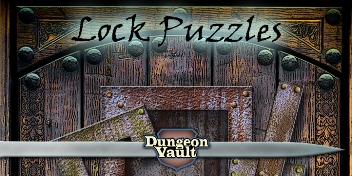
Lock Puzzles can be placed onto doors, ancient tomes, chests, and anything else you wish to secure really. The system is brilliantly easy to use and set up.
The pack comes with nine basic puzzles that each have three pieces. If you wish to create an easy challenge, just place one basic puzzle on a door. But start combining these basic puzzles, and they become increasingly difficult to solve. For intstance, if you place all nine puzzles on the same door the average group might spend about half an hour solving the puzzle. Place a single basic puzzle on a door and they’ll solve it in seconds. Oh, did we mention there are over 500 ways to combine these nine basic puzzles? So don’t worry about replay value! Door puzzles comes in printable and VTT format.
Adding doors to your mazes is a very clever way to focre your players to explore the entire maze. You can hide the key pieces for each door throughout the maze or on monsters. This way you control how PCs flow from one part of your maze to the next.
Dark Ulf is the founder and editor of DNDpuzzles.com. When not writing for DNDpuzzles he travels the multiverse and destroys demons with a crossbow in one hand and a crossword in the other.
We hope this site inspires you to put more puzzles into your D&D games.



